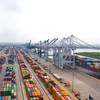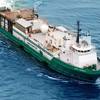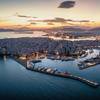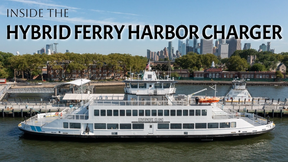New security regulations and specially trained port security teams are among the newest tools being employed in Operation Neptune Shield, the Coast Guard's plan for fighting the global war on terrorism here at home, as military operations continue against Taliban and Al-Qaida fighters overseas. "Since Sept. 11, the Coast Guard has implemented a multi-layered strategy for protecting our ports and waterways," said Atlantic Area Commander Vice Adm. Thad Allen. "Under Operation Neptune Shield, new regulations, additional resources and a closer working relationship with our intelligence and law enforcement partners have allowed us to harden our borders. It's a matter of the whole being greater than the sum of its parts."
"As we work to enhance the Coast Guard's multi-mission capabilities over time, through cooperative planning with other agencies, the Department of Transportation, Congress and the administration's Office of Homeland Security, we will continue to do all we can to protect and preserve life and property on the high seas, along our coastline and in our ports and waterways," Allen said.
Among the Coast Guard's newest tools for combating terrorism in 361 major U.S. ports are three specially trained rapid response Maritime Safety and Security Teams (MSSTs). Each MSST is composed of about 40 active duty Coast Guard men and women equipped with armed boats and trained to patrol, detect and counter maritime terrorism threats in U.S. ports and waterways. Since Sept. 11, the teams have been deployed to Boston, New York, Houston-Galveston, Hampton Roads, Va., and Puget Sound. Teams were also sent to provide waterborne security for this year's Super Bowl in New Orleans.
The three MSSTs, now deployed across the nation, were formed from the Coast Guard's Tactical Law Enforcement Team North, based in Yorktown, Va. Before Sept. 11, TACLET North conducted counter-drug operations in the Caribbean and Maritime Interdiction Force Operations with the Navy in Southwest Asia. The newly formed MSSTs were first deployed to replace Coast Guard Port Security Units (PSU) sent to protect U.S. ports immediately after the World Trade Center and Pentagon attacks, the first time PSU's were used domestically. Plans for an additional three Coast Guard MSSTs are contained in the administration's budget proposal for fiscal year 2003.
Two PSUs are currently deployed overseas, and two others are preparing for future deployments; PSU 305, Fort Eustis, Va., is deployed to Joint Task Force 160 in Guantanamo Bay in support of detention operations there, and PSU 311, San Pedro, Calif., is providing protection for U.S. and allied ships in Southwest Asia.
Other measures put into place since Sept. 11 include the stand-up of the Coast Guard's new National Vessel Movement Center, that tracks the arrival and movement of all foreign flagged vessels intending to enter the U.S. Commercial vessels over 300 gross tons are required to provide information about their cargo, crew and ship, 96 hours in advance of arrival, up from just 24 hours in advance before Sept. 11.
In September, both the Atlantic and Pacific Area commanders established a new temporary regulation prohibiting vessels from approaching closer than 100 yards of any U.S. Navy vessel in U.S. waters without permission. The Coast Guard has proposed the Naval Vessel Protection Zone (NVPZ) regulation become permanent June 15, when the temporary order expires. The NVPZ regulation also requires vessel operators to maintain slow speed when passing within 500 yards of any Navy ship.
In its largest port security operation since WWII, the Coast Guard has: Conducted more than 35,000 port security patrols on the water; Conducted more than 3,500 air surveillance patrols; Boarded more than 2,000 vessels determined to be of high interest; and Escorted 6,000 vessels in and out of port.
The Coast Guard has also joined forces with the Navy. In ports like Hampton Roads, the Coast Guard Captain of the Port and Navy commands there operate a Joint Harbor Operations Center (JHOC). The JHOC serves as a command and control center for maritime homeland security in the port. The JHOC integrates radar coverage of the harbor with surveillance cameras and other information to monitor and track the movement of ships in the regulated navigation area established for the port. This unique operating agreement allows Navy and Coast Guard forces to share a common tactical picture and synthesize information and resources needed to protect the largest concentration of naval ships in the world.
In another effort to work more closely with the Navy, 13 Special Operations Command Naval ships have been assigned to the Coast Guard for Homeland Security duties. These highly capable, armed ships with a six-person Coast Guard boarding team conduct coastal patrol and port security operations in ports like Boston, New York, Hampton Roads, Miami, Houston, Los Angeles and Puget Sound.
The Coast Guard has also been working with the International Maritime Organization to enhance the security of foreign flagged commercial ships, and is now experimenting with fast-roping from Coast Guard helicopters - a method where Coast Guard boarding teams are lowered to the decks of commercial ships at sea to increase the efficiency and safety of boardings.
Sponsored Content
Built for Battle. Proven by Shipbuilders.

Meet The New Standard in Underwater Connectivity

Subscribe for
Maritime Reporter E-News
Maritime Reporter E-News is the maritime industry's largest circulation and most authoritative ENews Service, delivered to your Email five times per week










